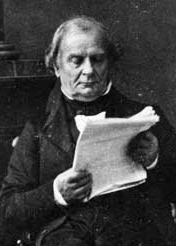Benoît Paul Émile Clapeyron facts for kids
Quick facts for kids
Benoît Clapeyron
|
|
|---|---|
 |
|
| Born | 26 January 1799 |
| Died | 28 January 1864 (aged 65) |
| Nationality | French |
| Known for | Second law of thermodynamics Ideal gas law Clapeyron's theorem Clapeyron's theorem of three moments Clapeyron equation Clausius-Clapeyron relation |
| Scientific career | |
| Fields | Physics |
Benoît Paul Émile Clapeyron (born January 26, 1799 – died January 28, 1864) was a French engineer and scientist. He is known as one of the people who helped create the field of thermodynamics, which is the study of heat and energy.
Contents
Early Life and Education
Benoît Clapeyron was born in Paris, France. He studied at the École polytechnique, a famous engineering school, and finished his studies in 1818. He also went to the École des mines, which is a school for mining engineers.
In 1820, Clapeyron and his friend Gabriel Lamé moved to Saint Petersburg, Russia. They worked and taught at a school for public works there.
Return to France and Railway Work
Clapeyron returned to Paris after the Revolution of July 1830. This was a big event in French history.
Back in France, he worked on building the first railway line. This important railway connected Paris to Versailles and Saint-Germain. He even traveled to England in 1836 to find a company to build his steam engine designs. He worked with a company called Sharp, Roberts and Co.
From 1844 to 1859, Clapeyron was a professor at the École des Ponts et Chaussées, another important engineering school in France.
Clapeyron married Mélanie Bazaine. Her father, Pierre-Dominique Bazaine, was a mathematician and engineer. Her brothers were also well-known: one was a railway engineer and the other became a Marshal of France.
Scientific Discoveries
In 1834, Clapeyron made a big contribution to modern thermodynamics. He published a report called Mémoire sur la puissance motrice de la chaleur, which means "Memoir on the Motive Power of Heat."
Understanding Heat Engines
In his report, Clapeyron built upon the ideas of another physicist, Nicolas Léonard Sadi Carnot. Carnot had studied how heat engines work, but he used an older theory about heat.
Clapeyron made Carnot's ideas easier to understand. He used graphs to show how a heat engine works in a cycle. This graph, which shows pressure against volume, is sometimes called Clapeyron's graph. His work helped spread Carnot's ideas to more scientists.
Laws of Thermodynamics
Clapeyron also studied the best way for valves in a steam engine to open and close.
In 1843, he further developed the idea of a reversible process. This idea was first suggested by Carnot. Clapeyron then clearly stated what is now known as the second law of thermodynamics. This law helps explain how heat and energy move and change.
Phase Transitions
Clapeyron also worked on what happens when matter changes from one phase to another, like ice melting into water. He helped develop a formula called the Clausius–Clapeyron relation. This formula describes how temperature and pressure affect these phase changes. He also looked at problems related to freezing and melting, which are now called Stefan problems.
Other Important Work
Clapeyron also studied perfect gases and how solid materials stay balanced. He developed ways to calculate the strength of continuous beams, which are important in building structures. One of his important findings is known as the theorem of three moments.
Honors and Legacy
- Clapeyron became a member of the Académie des Sciences in 1858.
- A street in Paris is named after him: the Rue Clapeyron in the 8th part of the city.
- His name is one of the 72 names inscribed on the Eiffel Tower, honoring important French scientists and engineers.
See also
 In Spanish: Émile Clapeyron para niños
In Spanish: Émile Clapeyron para niños

